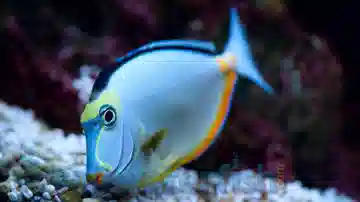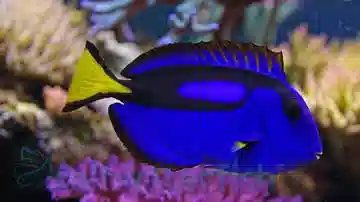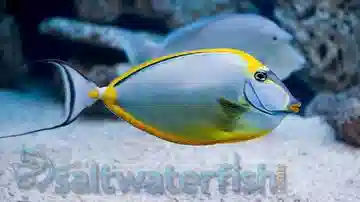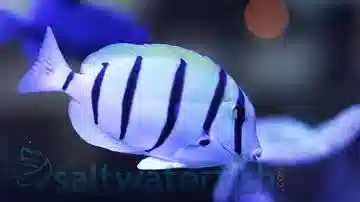Convict Tang
Acanthurus triostegus
(2 Reviews)

Convict Tang
Acanthurus triostegus
(2 Reviews)
{{ item.name }}
Size: {{ item.extra_field_3 }}
${{ getFormattedPrice(item.saleprice) }} ${{ getFormattedPrice(item.price) }}
To join the waiting list, click here
Free Shipping
With
$199.00
or more in Marine Life.
More details...
Convict Tang Care Facts
| Care Level: | Easy |
|---|---|
| Temperament: | Peaceful |
| Diet: | Omnivore |
| Reef Safe: | Yes |
| Minimum Tank Size: | 120 gallons |
| Max Size: | 8 inches |
The Convict Tang is also commonly referred as the Convict Surgeonfish. It features a stunning white to silver body highlighted with six vertical black bars that adds a captivating addition to any tank. The Convict Tang features peduncle spines near the tail in a small size, unlike other tangs which has bigger spines. The Convict Tang should not be housed with other tangs, but can lives peacefully with the same specie fish, i.e. other Convict Tangs, if introduced at the same time. It does not have any distinguishing characteristics that can differentiate males from females. It is mainly a herbivore but feeds on meaty foods as well. It is also important to provide them plenty of marine based seaweed and algae. The Convict Tang should be fed at least three times per week with dried seaweed tied to a rock.
Convict Tang (Acanthurus triostegus): A Practical Care Guide
The Convict Tang, scientifically known as Acanthurus triostegus, is a popular and hardy marine species that can be a valuable addition to your saltwater marine aquarium. This comprehensive guide will provide essential information on caring for this intriguing fish, covering its habitat, compatibility, diet, care requirements, and more.
Habitat of the Convict Tang
Convict Tangs are native to the tropical waters of the Indo-Pacific region, specifically in areas near coral reefs and rocky shorelines. They inhabit depths ranging from 1 to 40 feet (0.3 to 12 meters) and are commonly found in areas with strong water flow, such as reef slopes and channels.
Reef Compatibility of the Convict Tang
This species is generally considered reef-safe. Convict Tangs are herbivorous and primarily feed on algae. They can help control algae growth on live rock and coral surfaces in captivity. While they occasionally graze on some macroalgae, their impact on coral health is minimal.
Size and Lifespan of the Convict Tang
Convict Tangs typically reach about 6 to 8 inches (15 to 20 cm) when fully mature. They can live 5 to 7 years in captivity with proper care, offering several years of enjoyment for dedicated aquarists.
Diet in Captivity of the Convict Tang
In their natural habitat, Convict Tangs primarily feed on various types of algae, including film and macroalgae. In captivity, it's crucial to replicate their natural diet. Provide them with high-quality marine algae sheets, seaweed, and a mix of marine pellets and frozen foods such as brine shrimp and mysis shrimp.
Aquaculture and Availability of the Convict Tang
Convict Tangs are not available through aquaculture. However, Saltwaterfish.com is committed to providing hobbyists with responsibly sourced fish, ensuring that each Convict Tang is healthy, acclimated, and ready to thrive in your aquarium.
Compatibility with Other Fish and Invertebrates of the Convict Tang
Convict Tangs are generally peaceful and can coexist with a wide range of tank mates. However, they may exhibit territorial behavior toward other tangs or fish with similar body shapes. Ensure your aquarium is large enough to accommodate their swimming and territorial needs.
Sexual Dimorphism of the Convict Tang
Sexual dimorphism in Convict Tangs is minimal, and distinguishing between males and females based on visual characteristics is challenging.
Juvenile to Adult Coloration Changes of the Convict Tang
Juvenile Convict Tangs typically exhibit a striking black-and-white coloration with alternating bands. As they mature into adults, their coloration may become less vivid, with some individuals developing a more subdued appearance.
Temperament of the Convict Tang
Convict Tangs are known for their generally peaceful character. They are social fish and can thrive when kept with other peaceful tank mates. However, as with any fish, providing them with sufficient space and hiding spots is essential to reduce potential territorial conflicts.
Tank Requirements of the Convict Tang
To provide the best care for your Convict Tang, maintain a tank with a minimum size of 120 gallons. Larger tanks are recommended for multiple tangs or when housing them with other tang species. Water conditions should mimic their natural habitat, with a pH level between 8.1 and 8.4, a salinity level of 1.020-1.025, a stable temperature between 74-78°F (23-26°C), and moderate water flow to simulate ocean currents.
Common Names of the Convict Tang
The Convict Tang is also known by various names, including Convict Surgeonfish and Convict Blenny.
Compatible Tank Mates of the Convict Tang
Here are five specific species that can make suitable tank mates for your Convict Tang:
- Royal Gramma (Gramma loreto)
- Yellowtail Damsel (Chrysiptera parasema)
- Firefish Goby (Nemateleotris magnifica)
- Six-Line Wrasse (Pseudocheilinus hexataenia)
- Cleaner Shrimp (Lysmata amboinensis)
Why Choose the Convict Tang from Saltwaterfish.com
When you acquire a Convict Tang from Saltwaterfish.com, you're investing in a hardy and adaptable addition to your saltwater marine aquarium. Saltwaterfish.com is dedicated to responsibly sourced fish, ensuring each Convict Tang is healthy, acclimated, and ready to thrive in your aquarium. With their commitment to quality and a wealth of resources, Saltwaterfish.com makes it easy to enjoy these tangs' unique beauty in your home aquarium.
The Convict Tang (Acanthurus triostegus) offers a striking and adaptable presence in saltwater marine aquariums. With their unique coloration and hardy nature, they can be a valuable choice for both beginner and experienced aquarists looking to add a touch of vibrancy to their collection. By adhering to their specific requirements and providing a suitable environment, aquarists can witness the Convict Tang's presence in their aquatic habitat.
Beautiful tangs, they really added contrast & motion to the tank. Started eating pellets within hours of introduction. They can be mean to other tangs & even each other, even though they are big schoolers. Definitely get any amount all together. If u DO add more later, don't just add a single one, add multiple ones-but only if u have a big enough tank. If I had a big enough tank I would love to get a school of 5 or 6!
Reviewed by: Lawrence Page on Oct. 9, 2016
This is my first experience with a convict tang although I have had several tangs throughout the years. It has adapted well and loves to graze all day long. Seems to be a bit hyper, but that is ok with me. It gives the tank some action. I also have a Tomini tang and seems to be ok with him as well. It does not bother anyone in the tank and is of course coral safe. Seems to be a nice addition to my tank.
Reviewed by: Joseph Klingbeil on March 21, 2016















